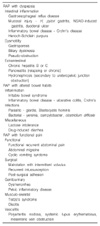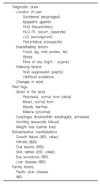1. Starfield B, Hoekelman RA, McCormick M, Benson P, Mendenhall RC, Moynihan C, et al. Who provides health care to children and adolescents in the United States? Pediatrics. 1984. 74:991–997.

2. Hyams JS, Burke G, Davis PM, Rzepski B, Andrulonis PA. Abdominal pain and irritable bowel syndrome in adolescents: a community-based study. J Pediatr. 1996. 129:220–226.

3. Frank L, Kleinman L, Rentz A, Ciesla G, Kim JJ, Zacker C. Health-related quality of life associated with irritable bowel syndrome: comparison with other chronic diseases. Clin Ther. 2002. 24:675–689.

4. Drossman DA, Li Z, Andruzzi E, Temple RD, Talley NJ, Thompson WG, et al. U.S. householder survey of functional gastrointestinal disorders. Prevalence, sociodemography, and health impact. Dig Dis Sci. 1993. 38:1569–1580.
5. Talley NJ, Gabriel SE, Harmsen WS, Zinsmeister AR, Evans RW. Medical costs in community subjects with irritable bowel syndrome. Gastroenterology. 1995. 109:1736–1741.

6. Campo JV, Di Lorenzo C, Chiappetta L, Bridge J, Colborn DK, Gartner JC Jr, et al. Adult outcomes of pediatric recurrent abdominal pain: do they just grow out of it? Pediatrics. 2001. 108:E1.
7. Apley J, Naish N. Recurrent abdominal pains: a field survey of 1,000 school children. Arch Dis Child. 1958. 33:165–170.

8. American Academy of Pediatrics Subcommittee on Chronic Abdominal Pain. Chronic abdominal pain in children. Pediatrics. 2005. 115:812–815.
9. Kohli R, Li BU. Differential diagnosis of recurrent abdominal pain: new considerations. Pediatr Ann. 2004. 33:113–122.

10. Boey CC, Goh KL. Psychosocial factors and childhood recurrent abdominal pain. J Gastroenterol Hepatol. 2002. 17:1250–1253.

11. Noe JD, Li BU. Navigating recurrent abdominal pain through clinical clues, red flags, and initial testing. Pediatr Ann. 2009. 38:259–266.

12. Di Lorenzo C, Colletti RB, Lehmann HP, Boyle JT, Gerson WT, Hyams JS, et al. American Academy of Pediatrics Subcommittee on Chronic Abdominal Pain. NASPGHAN Committee on Abdominal Pain. Chronic abdominal pain in children: a clinical report of the American Academy of Pediatrics and the North American Society for Pediatric Gastroenterology, Hepatology and Nutrition. J Pediatr Gastroenterol Nutr. 2005. 40:245–248.

13. Hwang JB, Jeong SH. Practical diagnostic approaches to chronic abdominal pain in children and adolescents. J Korean Med Assoc. 2009. 52:271–284.

14. von Baeyer CL. Understanding and managing children's recurrent pain in primary care: a biopsychosocial perspective. Paediatr Child Health. 2007. 12:121–125.







 PDF
PDF ePub
ePub Citation
Citation Print
Print










 XML Download
XML Download